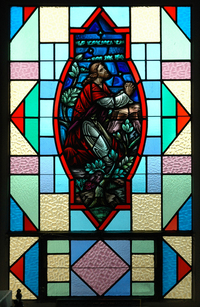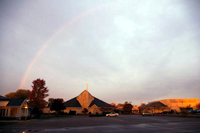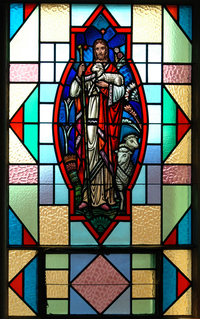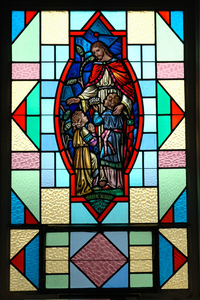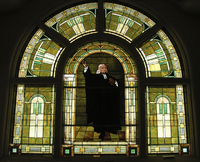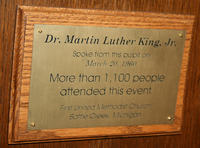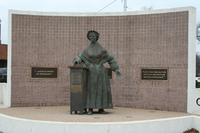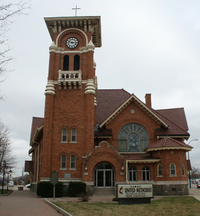MSGC : Featured Windows : Current Window
Featured Windows, January-February 2012
First United Methodist Church, Battle Creek, Michigan
Building: First United Methodist Church
City: Battle Creek
State: Michigan
First United Methodist Church, Battle Creek, MI. Built 1907-1908. Wilbur Thoburn Mills, architect. 1998 addition: Larry Rizor, architect.
First United Methodist Church had its beginning in 1833, when a group of Battle Creek Methodists began meeting in their cabins and log schoolhouse. In 1841 they built a small wood frame church on the site where the Battle Creek City Hall now stands. Noted abolitionist Horace Greeley spoke at the church in 1854. The first church home was followed by a large brick building, constructed in 1859-1860 across the street on the triangular site of the present church. Sojourner Truth, Battle Creek resident and nationally known leader for women’s rights and racial equality, spoke at this second church. The third and present church, designed by Wilbur Thoburn Mills of Columbus, Ohio, was completed in 1908. Its distinguishing features include a red tile roof and a prominent bell tower. A large addition, designed by architect and church member Larry Rizor of Battle Creek, was dedicated in 1998. The Rev. Dr. Martin Luther King, Jr. preached a Lenten sermon at the third church on March 20, 1960. A church plaque notes that more than 1100 people attended the historic event. In 2008 First United Methodist Church celebrated 175 years of Methodism in Battle Creek and 100 years in its present building. The building is listed on both the National Register of Historic Places and Michigan State Historic Sites.
The stained glass windows of First United Methodist Church were created by two leading studios. The Flanagan & Biedenweg Company of Chicago provided the 1908 octagonal dome skylight and windows for the sanctuary and other areas of the building; five medallion-type windows for the chapel were designed by Stanley Elmore Worden (1905-1994) and fabricated in 1963-1965 at the Henry Keck Stained Glass Studio of Syracuse, NY.
Joseph E. Flanagan (1858-1928) and William C. Biedenweg (1853-1914), a German trained craftsman, founded Flanagan & Biedenweg Co. in 1878. The firm became the largest Chicago producer of stained glass by 1900 and was active until 1953. German-born Henry Keck (1874-1956) apprenticed at Tiffany Studios, had further training in Munich and New York, and worked for the Lamb and Pike studios before opening his own studio at Syracuse in 1913. Designer and painter Stanley Worden joined the Keck Studio in 1922, became its director after Keck’s death in 1956, and remained with the firm until it closed in 1974.
Ascension Window. This large sanctuary window depicting the Ascension of Christ is one of three figural windows created for the church in 1908 by Flanagan & Biedenweg Co. Decorative stained glass windows made by the same firm are located throughout the church.
Good Shepherd Window. Flanagan & Biedenweg Co., 1908. A second figural sanctuary window presents the familiar view of Jesus as a good shepherd.
John Wesley Window. Flanagan & Biedenweg Co., 1908. This balcony window depicts John Wesley (1703-1791), English theologian, evangelist and founder of Methodism.
Gethsemane Chapel Window. Stanley Worden, Henry Keck Stained Glass Studio, 1963-65. Jesus praying in the Garden of Gethsemane is the subject of this medallion window.
Good Shepherd Chapel Window. Stanley Worden, Henry Keck Stained Glass Studio, 1963-65. This window offers another interpretation of the familiar good shepherd theme.
Jesus and the Children Chapel Window. Stanley Worden, Henry Keck Stained Glass Studio, 1963-65. The popular scene of Jesus with the children is shown in this medallion window.
A plaque commemorates the historic event of March 20, 1960, when Dr. Martin Luther King Jr. spoke from the pulpit of First United Methodist Church.
This 12-foot bronze statue of Sojourner Truth (c.1797-1883), located in downtown Battle Creek, was designed by sculptor Tina Allen and dedicated in 1999. Truth, a resident of Battle Creek, spoke at the 1860 church home of First United Methodist Church. She is buried in Battle Creek’s Oak Hill Cemetery.
First United Methodist Church of Battle Creek was registered in the Michigan Stained Glass Census by Carolyn Harvey; Jay Weiss; Jerry Mackey, photographer; Larry Rizor, architect; and Kurt Thornton, historian (MSGC 08.0006).
Bibliography:
Show BibliographyAshlee, Laura Rose, ed. Traveling Through Time: A Guide to Michigan's Historical Markers, Rev. ed. Ann Arbor: The University of Michigan Press, 2005, p. 61.
Carson, Karla, ed. First United Methodist Church Anniversary Album. Battle Creek, MI: First United Methodist Church, September, 2008.
“Downtown landmark church to celebrate 175 years.” Battle Creek Shopper News. Sept. 25, 2008, pp.2, 5.
Eckert, Kathryn Bishop, ed. Buildings of Michigan. New York: Oxford University Press, 1993, p. 205.
First United Methodist Church, Battle Creek, Michigan. http://firstumcbc.org/
“First United Methodist Church Historical Review: 1908-2008.” (Leaflet) Battle Creek, MI: First United Methodist Church, December, 2008.
Harvey, Carolyn. “Descendants of Battle Creek’s first Methodist meeting celebrate 175th.” Michigan Christian Advocate. http://www.mcadvocate.org/home
Holcomb, Lori. “Celebrating history.” Battle Creek Enquirer. March 13, 2008, p. 10.
Holcomb, Lori. “First United Methodist congregation celebrates 175th anniversary.” Battle Creek Enquirer, Sept. 21, 2008, p. 1C.
The Holy Bible, King James Version. New York: American Bible Society, 1999.
Jones, Robert O. Biographical Index of Historic American Stained Glass Workers. Kansas City, MO: Stained Glass Association of America, 2002.
Reed, Cleota, ed. Henry Keck Stained Glass Studio, 1913-1974. Syracuse, NY: Syracuse University Press, 1985. (MSGC 2008.0006)
Text by Betty MacDowell, Michigan Stained Glass Census, January , 2012.


